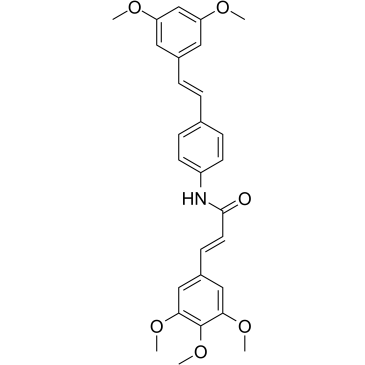| Cas No.: | 2059952-75-7 |
| Chemical Name: | STAT3-IN-1 |
| SMILES: | COC1C=C(/C=C/C2C=CC(NC(=O)/C=C/C3C=C(OC)C(OC)=C(OC)C=3)=CC=2)C=C(OC)C=1 |
| Formula: | C28H29NO6 |
| M.Wt: | 475.53 |
| Purity: | >98% |
| Sotrage: | 2 years -20°C Powder, 2 weeks 4°C in DMSO, 6 months -80°C in DMSO |
| Publication: | [1]. Li S, et al. Discovery of oral-available resveratrol-caffeic acid based hybrids inhibiting acetylated and phosphorylated STAT3 protein. Eur J Med Chem. 2016 Nov 29;124:1006-1018. |
| Description: | STAT3-IN-1 (compound 7d) is an excellent, selective and orally active STAT3 inhibitor, with IC50 values of 1.82 μM and 2.14 μM in HT29 and MDA-MB 231 cells, respectively. STAT3-IN-1 (compound 7d) induces tumor apoptosis[1]. |
| Target: | IC50: 1.82 μM (STAT3 in HT29 cells), 2.14 μM (STAT3 in MDA-MB 231 cells)[1]. |
| In Vivo: | STAT3-IN-1 (compound 7d: 10, 20 mg/kg, two weeks) arrests tumor growth with low toxicity in mouse-xenograft model[1]. Animal Model: Mouse-xenograft model bearing inoculation of mice breast cancer 4T1 cells[1]. Dosage: 10, 20 mg/kg. Administration: Oral administration once every other day for two weeks. Result: Arrested tumor growth with no obvious body weight loss. |
| In Vitro: | STAT3-IN-1 (compound 7d: 0-10 μM, 48 h) inhibits the STAT3 acetylation at lysine 685 and affected its specific genes expressions[1]. STAT3-IN-1 (compound 7d: 0-10 μM, 48 h) induces tumor cells apoptosis in MDA-MB-231 cells[1]. Apoptosis Analysis[1] Cell Line: MDA-MB-231 cell lines. Concentration: 0-10 μM. Incubation Time: 48 hours. Result: The induced apoptosis rates (early and late apoptosis) at 1, 2, 5, 8 and 10 mM were 9.0%, 11.2%, 20.9%, 43.3% and 85.2% versus control 3.0%. Western Blot Analysis[1] Cell Line: MDA-MB-231 and HT-29 cell lines. Concentration: 0-10 μM. Incubation Time: 48 hours. Result: Inhibited STAT3 acetylation and STAT3 tyrosine phosphorylation in MDA-MB-231 cells. Increased the expressions of these tumor-suppressor genes (PTPN6 (SHP-1), CDKN2A and DLEC1) which were related to STAT3 acetylation at Lys685. |
| References: | [1]. Li S, et al. Discovery of oral-available resveratrol-caffeic acid based hybrids inhibiting acetylated and phosphorylated STAT3 protein. Eur J Med Chem. 2016 Nov 29;124:1006-1018. |

 To enhance service speed and avoid tariff delays, we've opened a US warehouse. All US orders ship directly from our US facility.
To enhance service speed and avoid tariff delays, we've opened a US warehouse. All US orders ship directly from our US facility.




















